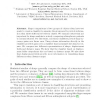Free Online Productivity Tools
i2Speak
i2Symbol
i2OCR
iTex2Img
iWeb2Print
iWeb2Shot
i2Type
iPdf2Split
iPdf2Merge
i2Bopomofo
i2Arabic
i2Style
i2Image
i2PDF
iLatex2Rtf
Sci2ools
MICCAI
2002
Springer
2002
Springer
Performance Issues in Shape Classification
Shape comparisons of two groups of objects often have two goals: to create a classifier to separate the groups and to provide information that shows differences between classes. We examine issues that are important for shape analysis in a study comparing schizophrenic patients to normal subjects. For this study, non-linear classifiers provide large accuracy gains over linear ones. Using volume information directly in the classifier provides gains over a classifier that normalizes the data for volume. We compare two different representations of shape: displacement fields and distance maps. We show that the classifier based on displacement fields outperforms the one based on distance maps. We also show that displacement fields provide more information in visualizing shape differences than distance maps.
| Added | 15 Nov 2009 |
| Updated | 15 Nov 2009 |
| Type | Conference |
| Year | 2002 |
| Where | MICCAI |
| Authors | Samson J. Timoner, Polina Golland, Ron Kikinis, Martha Elizabeth Shenton, W. Eric L. Grimson, William M. Wells III |
Comments (0)

